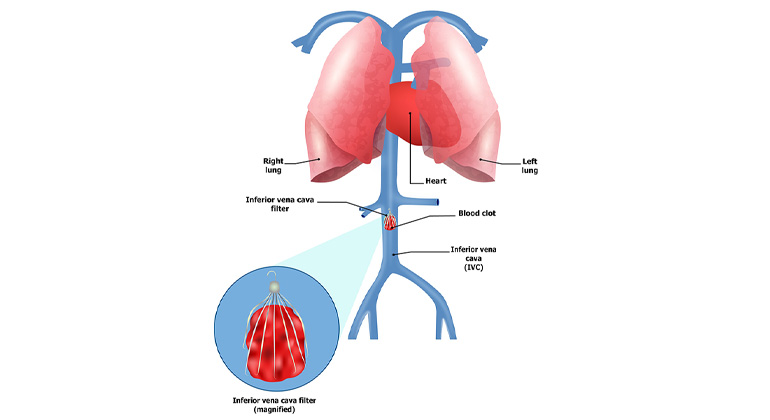Interior Vena Cava (IVC ) Filter Management

The inferior vena cava (IVC) is a large vein responsible for carrying blood from the lower part of your body (legs, pelvis, abdomen, kidneys) back to the right atrium of the heart. Some people have risk factors that increase their chance of forming blood clots in their veins that can break off and travel to the heart and lungs. These large blood clots can cause serious damage, resulting in life threatening consequences.
At Mount Sinai, our interventional radiologists are prepared to place any IVC filters.
IVC filters are metal devices that are placed in the IVC to catch and prevent these large blood clots from reaching the heart and lungs. Most people do not require IVC filters and can prevent these blood clots by taking “blood thinning” medications. Some select people are unable to take medications due to higher risk of bleeding, and will require IVC filters. IVC filters are placed by interventional radiologists using live x-rays (fluoroscopy) through a small pinhole in the neck or groin.
Like any surgical procedure, IVC filter placements can have certain risks including bleeding, damage to the IVC or surrounding organs, or infection. Additionally, any filter that has been in place longer than three to six months may put a patient at risk of serious complications.
These complications include:
- Breaking and traveling to the heart and lungs
- Increasing the risk of blood clots, particularly in the legs
- Damage to the IVC or surrounding organs
- Infection
IVC Filter Removal
All patients should be evaluated by an interventional radiologist to determine if their filters should be removed. Once the threat of a blood clot has passed, or if patients are now able to take blood thinning medications, they may be candidates for having their filters removed.
IVC (inferior vena cava) filter removal is a procedure in which an IVC filter that had previously been placed in the patient is retrieved. Most IVC filters can be removed easily. Some IVC filters can be problematic and require advanced filter retrieval techniques.
You will be scheduled to be seen in the IVC Filter Clinic by the nurse coordinator and interventional radiologist to discuss the filter removal procedure. You will then be scheduled in the interventional radiology department for the removal of the filter. On the day of the procedure you will not eat or drink anything after midnight and arrive at the time given to you by the filter coordinator. You do not need to stop taking any of your anticoagulation (blood thinning) medications for this procedure. You will receive sedation medication to make you comfortable and sleepy by a nurse for this procedure. Only a small incision will be made in your neck or groin to access the veins and place the sheath. This incision will be less than ½ an inch long. You will recover from the procedure and sedation medication for a few hours and then will be discharged home. Someone must be with you to take you home this day.
Why Mount Sinai?
Mount Sinai interventional radiologists have over 40 years of combined experience in thousands of filter placements and retrievals. Our interventional radiologists have particular clinical focus on difficult filter retrievals, and are frequently referred patients who could not have their filters removed elsewhere. We are involved in active clinical research and have developed advanced filter removal techniques with over 95 percent success.